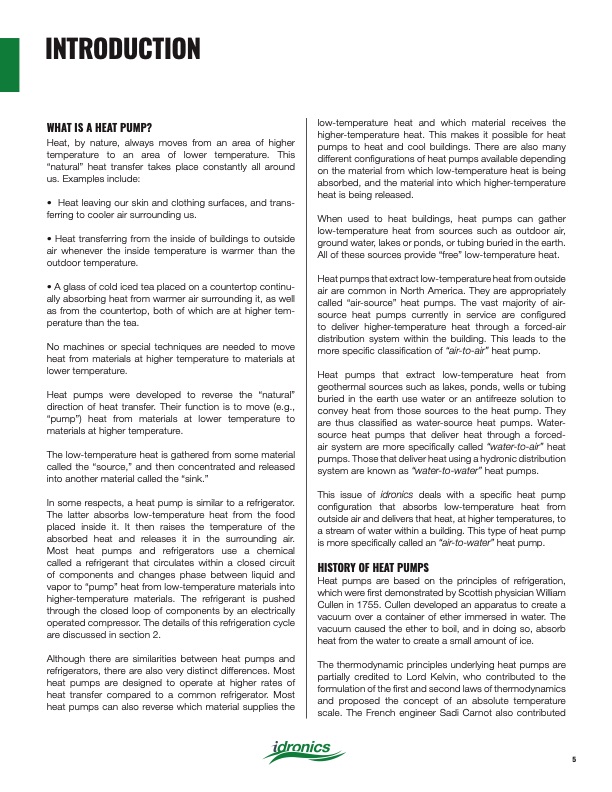
PDF Publication Title:
Text from PDF Page: 005
INTRODUCTION WHAT IS A HEAT PUMP? Heat, by nature, always moves from an area of higher temperature to an area of lower temperature. This “natural” heat transfer takes place constantly all around us. Examples include: • Heat leaving our skin and clothing surfaces, and trans- ferring to cooler air surrounding us. • Heat transferring from the inside of buildings to outside air whenever the inside temperature is warmer than the outdoor temperature. • A glass of cold iced tea placed on a countertop continu- ally absorbing heat from warmer air surrounding it, as well as from the countertop, both of which are at higher tem- perature than the tea. No machines or special techniques are needed to move heat from materials at higher temperature to materials at lower temperature. Heat pumps were developed to reverse the “natural” direction of heat transfer. Their function is to move (e.g., “pump”) heat from materials at lower temperature to materials at higher temperature. The low-temperature heat is gathered from some material called the “source,” and then concentrated and released into another material called the “sink.” In some respects, a heat pump is similar to a refrigerator. The latter absorbs low-temperature heat from the food placed inside it. It then raises the temperature of the absorbed heat and releases it in the surrounding air. Most heat pumps and refrigerators use a chemical called a refrigerant that circulates within a closed circuit of components and changes phase between liquid and vapor to “pump” heat from low-temperature materials into higher-temperature materials. The refrigerant is pushed through the closed loop of components by an electrically operated compressor. The details of this refrigeration cycle are discussed in section 2. Although there are similarities between heat pumps and refrigerators, there are also very distinct differences. Most heat pumps are designed to operate at higher rates of heat transfer compared to a common refrigerator. Most heat pumps can also reverse which material supplies the low-temperature heat and which material receives the higher-temperature heat. This makes it possible for heat pumps to heat and cool buildings. There are also many different configurations of heat pumps available depending on the material from which low-temperature heat is being absorbed, and the material into which higher-temperature heat is being released. When used to heat buildings, heat pumps can gather low-temperature heat from sources such as outdoor air, ground water, lakes or ponds, or tubing buried in the earth. All of these sources provide “free” low-temperature heat. Heat pumps that extract low-temperature heat from outside air are common in North America. They are appropriately called “air-source” heat pumps. The vast majority of air- source heat pumps currently in service are configured to deliver higher-temperature heat through a forced-air distribution system within the building. This leads to the more specific classification of “air-to-air” heat pump. Heat pumps that extract low-temperature heat from geothermal sources such as lakes, ponds, wells or tubing buried in the earth use water or an antifreeze solution to convey heat from those sources to the heat pump. They are thus classified as water-source heat pumps. Water- source heat pumps that deliver heat through a forced- air system are more specifically called “water-to-air” heat pumps. Those that deliver heat using a hydronic distribution system are known as “water-to-water” heat pumps. This issue of idronics deals with a specific heat pump configuration that absorbs low-temperature heat from outside air and delivers that heat, at higher temperatures, to a stream of water within a building. This type of heat pump is more specifically called an “air-to-water” heat pump. HISTORY OF HEAT PUMPS Heat pumps are based on the principles of refrigeration, which were first demonstrated by Scottish physician William Cullen in 1755. Cullen developed an apparatus to create a vacuum over a container of ether immersed in water. The vacuum caused the ether to boil, and in doing so, absorb heat from the water to create a small amount of ice. The thermodynamic principles underlying heat pumps are partially credited to Lord Kelvin, who contributed to the formulation of the first and second laws of thermodynamics and proposed the concept of an absolute temperature scale. The French engineer Sadi Carnot also contributed 5PDF Image | Heat Pump Systems 2020

PDF Search Title:
Heat Pump Systems 2020Original File Name Searched:
idronics_27_na.pdfDIY PDF Search: Google It | Yahoo | Bing
CO2 Organic Rankine Cycle Experimenter Platform The supercritical CO2 phase change system is both a heat pump and organic rankine cycle which can be used for those purposes and as a supercritical extractor for advanced subcritical and supercritical extraction technology. Uses include producing nanoparticles, precious metal CO2 extraction, lithium battery recycling, and other applications... More Info
Heat Pumps CO2 ORC Heat Pump System Platform More Info
| CONTACT TEL: 608-238-6001 Email: greg@infinityturbine.com | RSS | AMP |